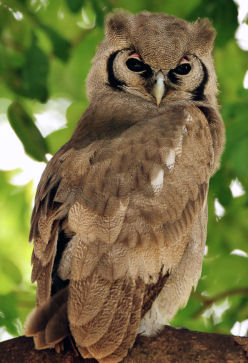Scientific Name: Bubo lacteus
African Names: Reuse Ooruil (Afrikaans), Reuse-ooruil (Afrikaans), Editika (Kwangali), Zizi (Shona), Kokoko (Swahili), Makgotlwê (Tswana), Nkhunsi (Tsonga), Ifubesi (Xhosa), iFubesi (Zulu)
 Length: 26-28 inches
Length: 26-28 inches Wingspan: Up to 6 feet
Average Adult Weight: 3.5 to 7 pounds
Life Span: 20 years
Description: The African Milky Eagle Owl is a large earred owl with dark eyes and bare pink eyelids. The owl's feathers are dark brown on top and light grey below.
Habitat: Dry savannah with scattered trees, riverine forest, semi-open woodland.
Countries found in: They are found in Sub-Saharan Africa, although not in the Namibian desert or in rainforests.
Babies: The African Milky Eagle Owl breeds from March to September. Two eggs are laid and are incubated by the female for thirty-eight days. During this time the male hunts for food for both of them. The first egg to hatch is the first to be fed. If there isn't enough food available only the first hatchling will be fed. If food is available both hatchlings will be fed.
At nine weeks, the chicks are ready to leave the nest but may remain with the parents for up to three months.
Food: African Milky Eagle Owls prey on a variety of animals including birds, game birds, ducks, crows, nestling herons, hares, mongoose, guinea fowl and many other small game animals. They also eat hedgehogs, rats and pigeons. They also consume frogs, beetles and crickets.
Group Name: A group of African Milky Eagle Owls is known as a parliament or stare of owls.
Habits: African Milky Eagle Owls make nests in hollow trees, on the ground of rocky caves, or take over hawk and eagle nests.
Conservation Status: Least Concern.
Interesting Facts: The African Milky Eagle Owl is the largest owl in Africa and the world's third largest owl.


